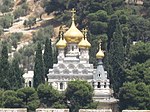Tomb of Benei Hezir
Archaeological sites in JerusalemJewish mausoleumsMount of OlivesRock-cut tombsTombs in the State of Palestine

The Tomb of Benei Hezir (Hebrew: קבר בני חזיר), previously known as the Tomb of Saint James, is the oldest of four monumental rock-cut tombs that stand in the Kidron Valley, adjacent to the Tomb of Zechariah and a few meters from the Tomb of Absalom. It dates to the period of the Second Temple. It is a complex of burial caves. The tomb was originally accessed from a single rock-cut stairwell which descends to the tomb from the north. At a later period an additional entrance was created by quarrying a tunnel from the courtyard of the monument known as "the Tomb of Zechariah". This is also the contemporary entrance to the burial complex.
Excerpt from the Wikipedia article Tomb of Benei Hezir (License: CC BY-SA 3.0, Authors, Images).Tomb of Benei Hezir
scări, Jerusalem Ras al-Amud
Geographical coordinates (GPS) Address Nearby Places Show on map
Geographical coordinates (GPS)
| Latitude | Longitude |
|---|---|
| N 31.776447222222 ° | E 35.239130555556 ° |
Address
קבר זכריה
scări
9114001 Jerusalem, Ras al-Amud
Jerusalem District, Israel
Open on Google Maps










